How to Design a Learning Commons
Key Points
-
Create fluidly connected spaces that foster collaborative, interdisciplinary, and self-directed learning.
-
Are critical to student-centered learning environments.
-
Have excellent natural light; strong indoor-outdoor connections; visual and permeable connections to adjacent spaces; diverse activity zones; varied furnishings, fixtures, and finishes; and good sound attenuation.
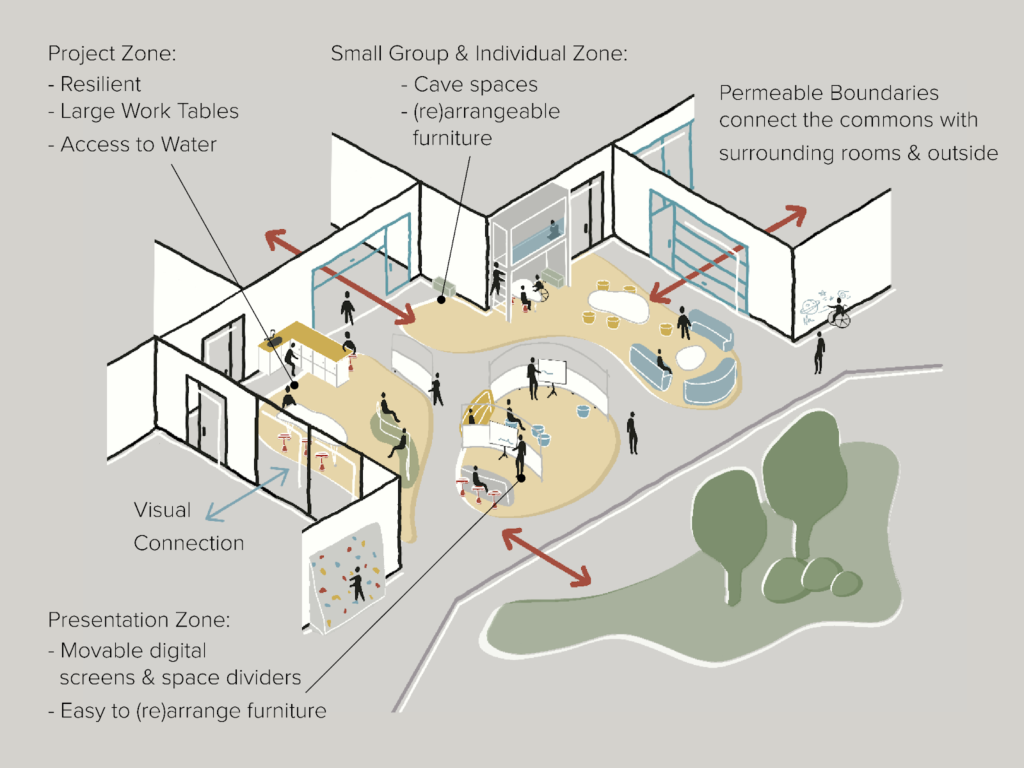
By: Randy Fielding, Cierra Mantz, Nathan Strenge
Problem: Most common areas are designed as secondary spaces, a place for breaking out from the classroom. But as schools transform from a traditional, classroom-based approach to a learner-centered approach, common areas become essential hubs of learning; and as such, require carefully orchestrated design.
In recent years, a learner-centered model of education has become increasingly popular. As a result, we at Fielding International see an emerging trend in the vision statements of many schools: there is an emphasis on multiple pathways toward excellence and achievement for all students. These statements often go on to call out specific student characteristics and skills such as holistic well-being, critical thinking, creative problem solving, technological and media literacy, communication, and collaboration. At the same time, most educators have begun to acknowledge that the physical learning environment is a key factor in supporting their educational vision – the environment can catalyze, or hinder, desired competencies.
One type of space that comes up again and again as having the potential to disrupt the isolated nature of the classroom model and align with the goals schools have today is the Learning Commons. A well-designed Learning Commons supports each of the competencies schools are trying to foster in their students; thus, it is an essential resource for any school seeking to achieve learner-centered visions. Despite people wanting access to Commons, they are often poorly designed and underutilized. So why do people want them in the first place?
A well-designed Learning Commons is foundational for creating fluidly connected spaces that foster collaborative, interdisciplinary, and self-directed learning. A well-designed Commons features spatial diversity which makes it possible to simultaneously facilitate learning experiences that incorporate a range of learning modalities. Spatial fluidity plus spatial diversity equals a kind of spatial agility that responds to the real-time needs of kids and adults alike, making them ideal places to cultivate dynamic communities built on relationships, belonging, and agency. So, if Learning Commons are so beneficial, and people actively want them, what can history tell us about why they are frequently ineffective?
As early as the open classroom moment of the 1970s and later in the middle school pod movement of the 1980s, the idea of communal learning areas was explored. Ultimately, these explorations failed for numerous reasons, many of which were spatial, including a lack of spatial diversity and limited connections to the outdoors (just to name a couple); but some of the reasons can also be attributed to a lack of professional resources and educational programming in support of the model.
In the decades since architects and educators first attempted to disrupt the notion that the classroom should be the primary place for learning, we’ve made significant progress regarding how we can design the physical environment to be an educational asset in the learning process. This article will focus on the spatial design components necessary for a well-designed Learning Commons. Specifically, we’ll discuss six key elements for thriving Learning Commons:
- Strong indoor-outdoor connections
- Visual and permeable connections to adjacent spaces
- Diverse activity zones
- Varied furnishings, fixtures, and finishes
- Sound attenuation
- Access to water and storage
Strong Indoor-Outdoor Connections
We can see many elements that support thriving in the Design Pattern sketch above. Foremost, a connection to the outside that offers natural light and views is important for nurturing a sense of wellness. In The Extended Mind, Annie Murphy Paul cites research that indicates students’ ability to look outside improves academic outcomes. Despite the awareness of humans’ innate desire to be connected with nature, and research showing its multilayered benefits, we see many flawed common areas which are surrounded by classrooms–essentially, widened corridors–without a connection to the outside. If the surrounding classrooms have natural light and the Learning Commons doesn’t, where will learners want to be?
An indoor-outdoor connection can also be reinforced through the use of natural building materials and finishes. In the photo of Schiffer Collaborative School below, we can see how the use of local stone, wood, and natural light contributes to an atmosphere of beauty and calm, mirroring the local landscape.
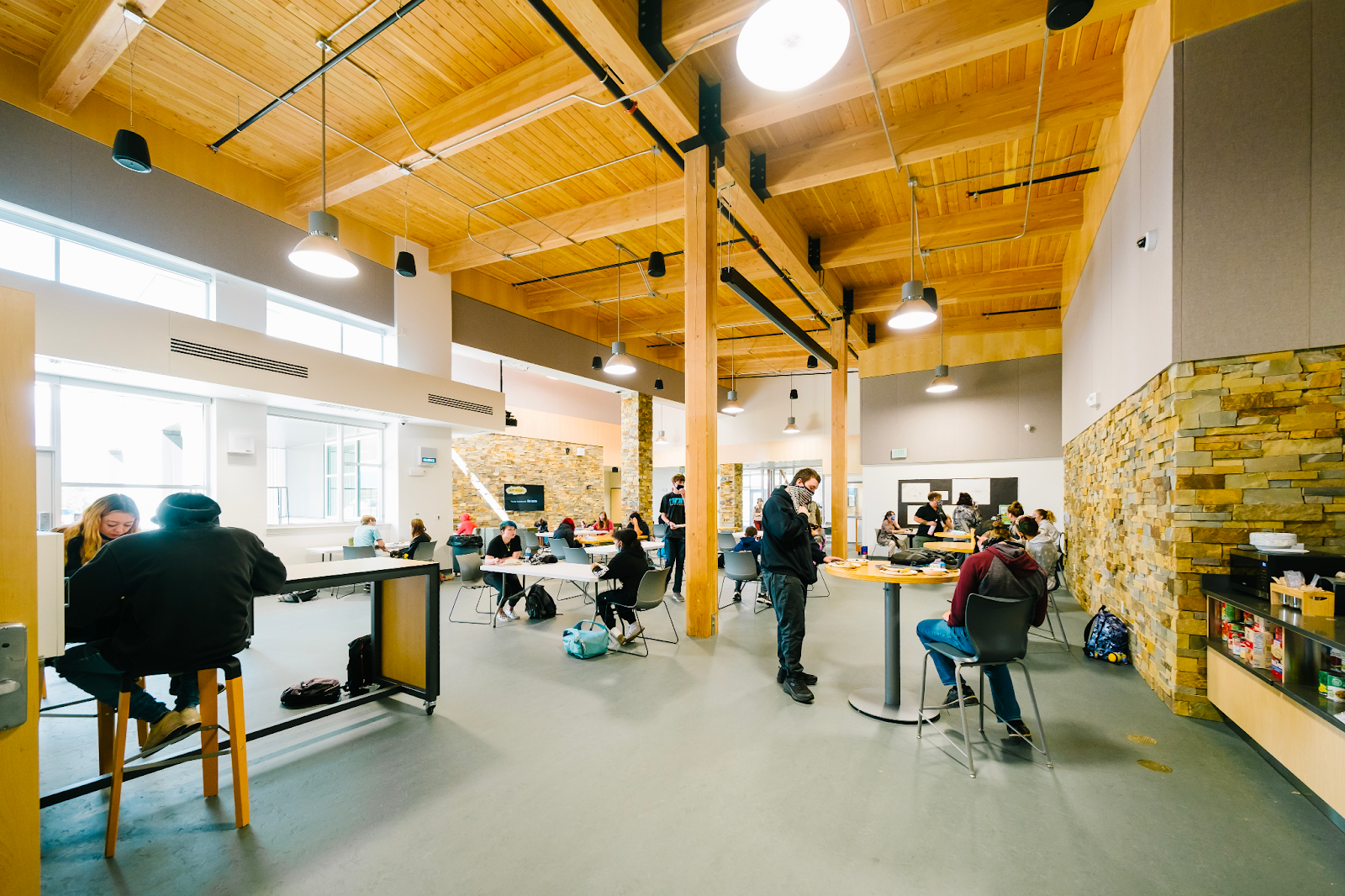
Visual & Permeable Connections to Adjacent Spaces
Strong visual connections and permeable boundaries between spaces invite students to walk, observe and engage with their peers and their environments inside and out. Interior windows, glass doors, and movable walls offer learners the opportunity to move outside their classrooms into adjacent project labs, learning studios, outdoor classrooms, and cave spaces where they can work individually and/or in groups while still receiving the benefit of visual supervision by teachers–an important element of safety. In addition to visually connected safety, students have the opportunity to connect with four to six teachers and around 100-120 students, versus one teacher and 20-30 students in a conventional classroom. As such, well-designed Learning Commons increases the odds that a learner will develop a close connection with an adult and peers, enhancing their sense of belonging.
In the image below, from Saint Francis of Assisi Elementary, we can see how permeable boundaries and visual connections facilitate student autonomy and collaboration among students and between students and teachers.
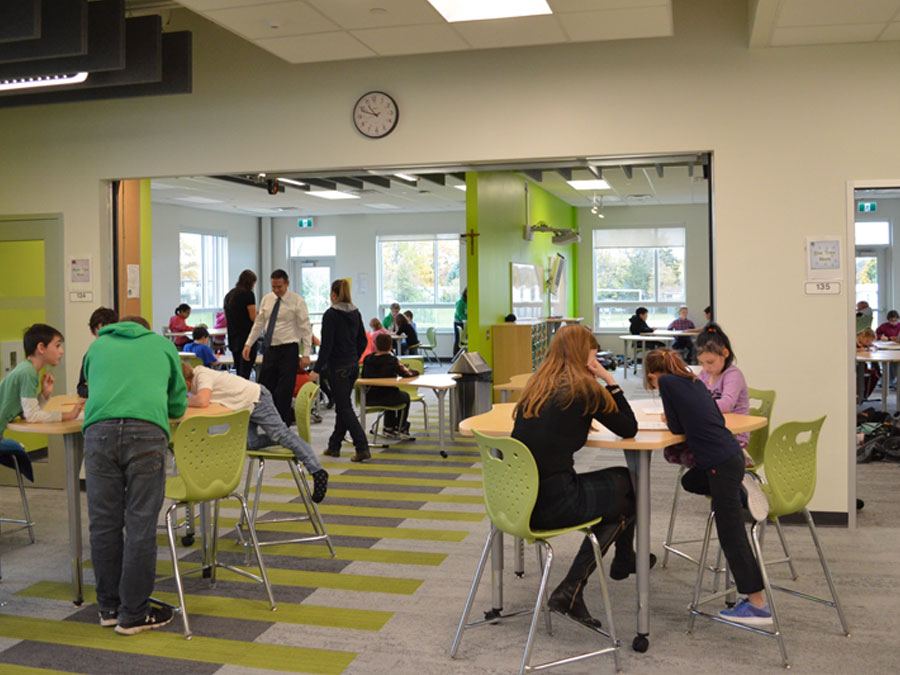
Diverse Activity Zones
Learning is a complex process that happens in many ways; therefore, it’s critical that the types of available spaces are designed to support multiple learning modalities as well as all aspects of the learning process. In order to design for this, spatial diversity is crucial. In the Design Pattern sketch at the beginning of the article, we see three activity zones: small group and individual, project zone, and presentation. While these three zones are not exhaustive of the types of zones a Learning Commons may have, they provide a framework for understanding how multiple zones can be created in a single open space. In addition to more broadly defined activity zones, for times in which a learner needs a quieter, personalized space, we provide cave spaces, calming retreats, and smaller tables or booths for independent work and reflection. These areas allow students to have personal space while still being visually connected to others.
In the image below, from South Clearfield Elementary, we can see how cave spaces provide a sense of partial enclosure–a space to feel secure, read quietly, and look out with curiosity and wonder.
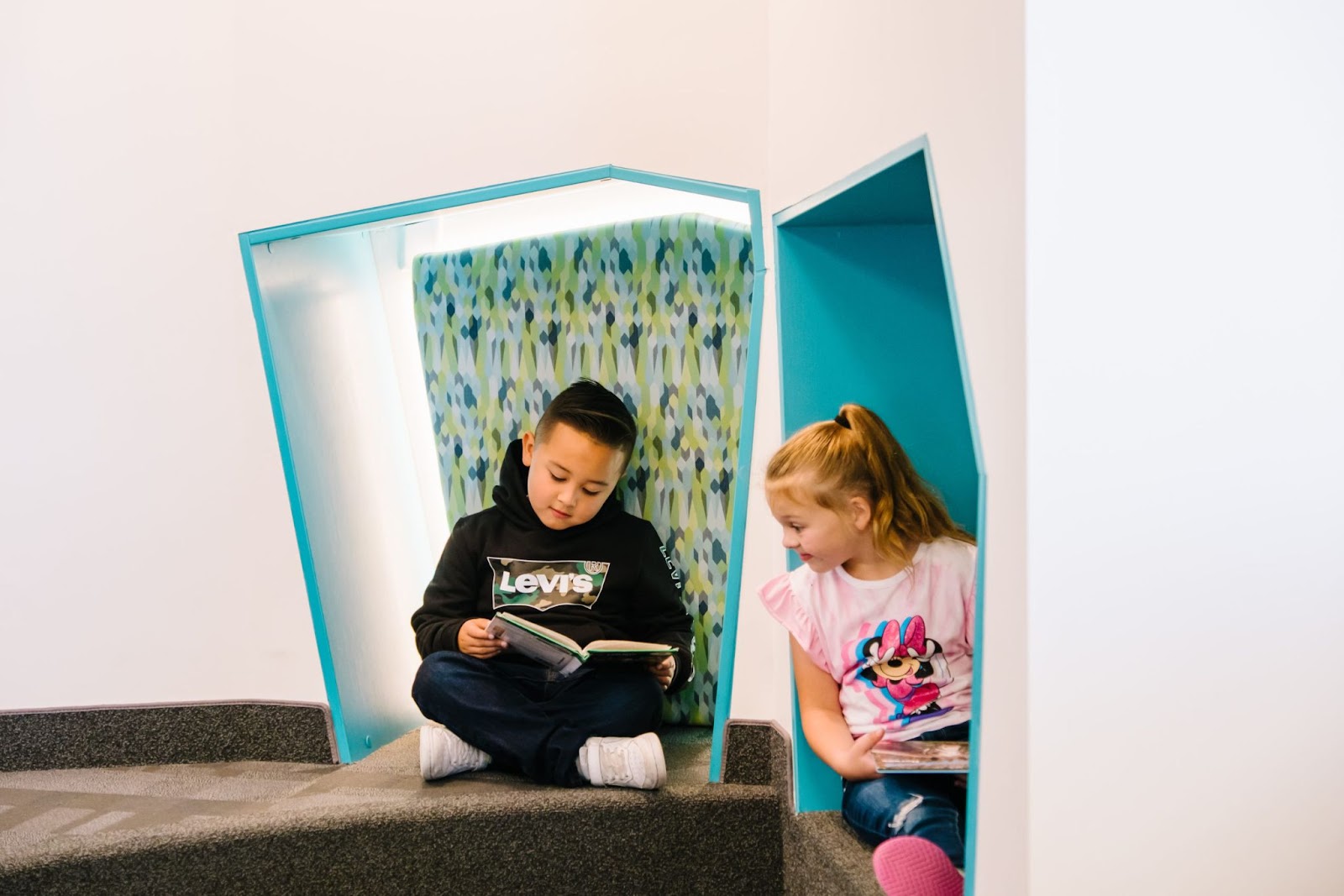
Varied Furnishings, Fixtures, and Finishes
Each activity zone has very distinct spatial features and qualities. As such, the interior design elements, including furniture, fixtures, equipment, and finishes become exceedingly important. For furniture, this means having a variety of seating arrangements and types, including a range of soft and hard seating options as well as tables of varying sizes and heights. Important fixtures and equipment to consider include, most importantly, lighting, but also audio-visual equipment and technology-enhanced furnishings for presentations and collaboration. Last, but certainly not least, finishes provide a crucial differentiator. From acoustic treatments to floor and wall finishes, the look, feel, and overall atmosphere of a space is defined by the finishes. For this reason, it is critically important that the finishes are intentionally selected with the activity zones in mind.
In the image below of Norma Rose Point Elementary, we see that the areas in front of the sink and within the learning studios have easily cleanable flooring that make this zone ideal for wet and messy projects.
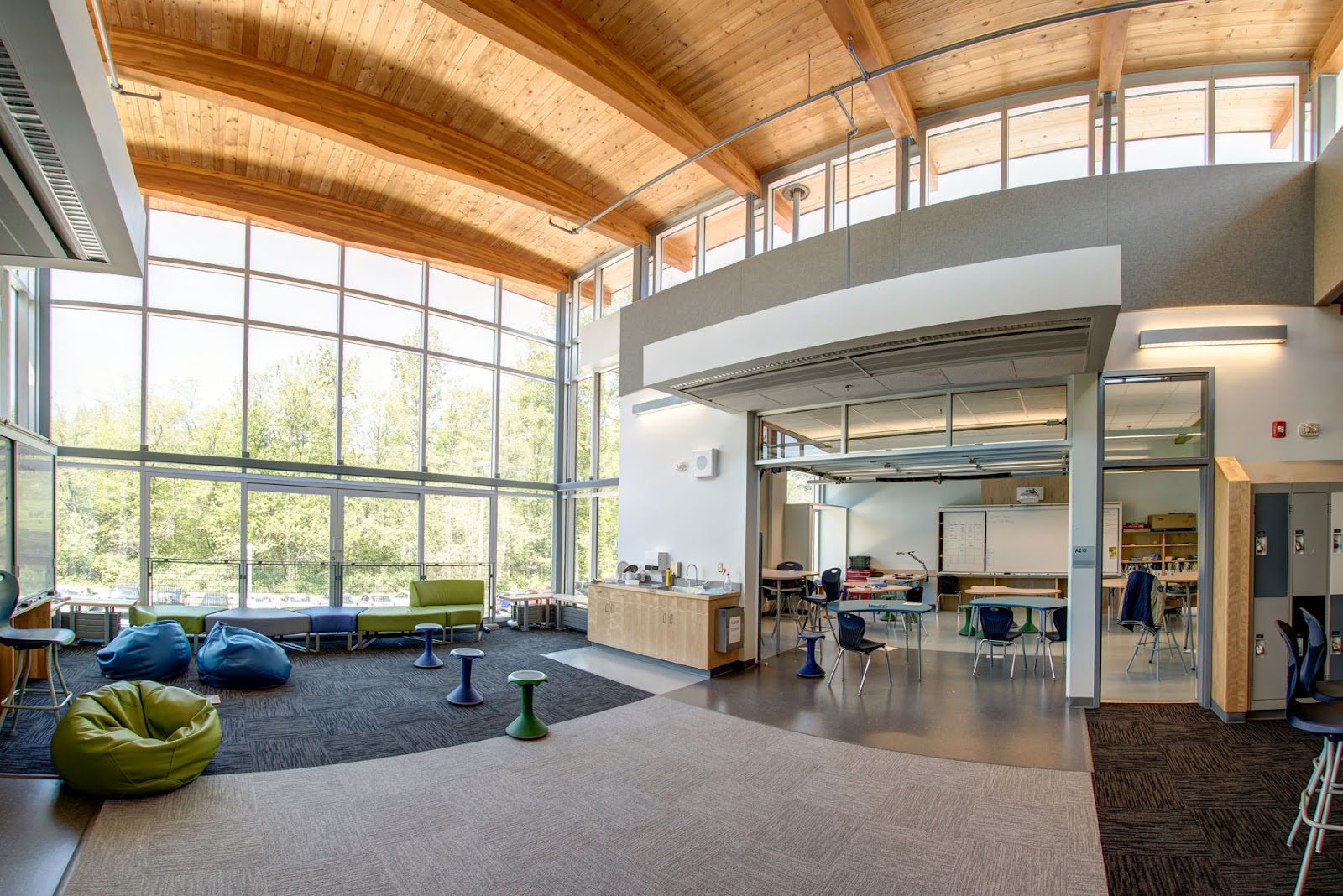
Sound Attenuation
One spatial characteristic that can make or break a Learning Commons is the acoustic design. Because a Learning Commons is an open, multi-zoned space, dampening the transmission of sound is critical. And yet, we often find this to be one of the most overlooked design elements. During a recent discovery visit, the importance of sound attenuation was reinforced over and over again. In advance of our arrival, school board leadership had toured an FI-designed school, Saint Francis of Assisi, and they were blown away by how tranquil the learning environments felt. In regards to the learning commons, they noted how easy it was to have a conversation on one side of the commons at the same time that a group of students was working in another part of the commons, while simultaneously an entire class had the garage door to a learning studio open and was moving in and out of the space as they transitioned from activity to activity.
All of the activity within the commons was able to co-exist because the sounds from each activity did not reverberate throughout the space; the sound was attenuated through the design and material selection for the ceilings, walls, and floors. In contrast, when we toured the newest school in their district, everywhere we went there was a cacophony of noise–even the spaces that were designed to be calming breakout spaces. As a result, many staff members were reticent to recommend open commons areas in future schools within the district. However, since the leadership group had experienced what a well-designed commons can feel like, they became the biggest advocates again and again countering any claims of how distracting open commons areas are with how effective and beneficial they can be when sound is well addressed in the design.
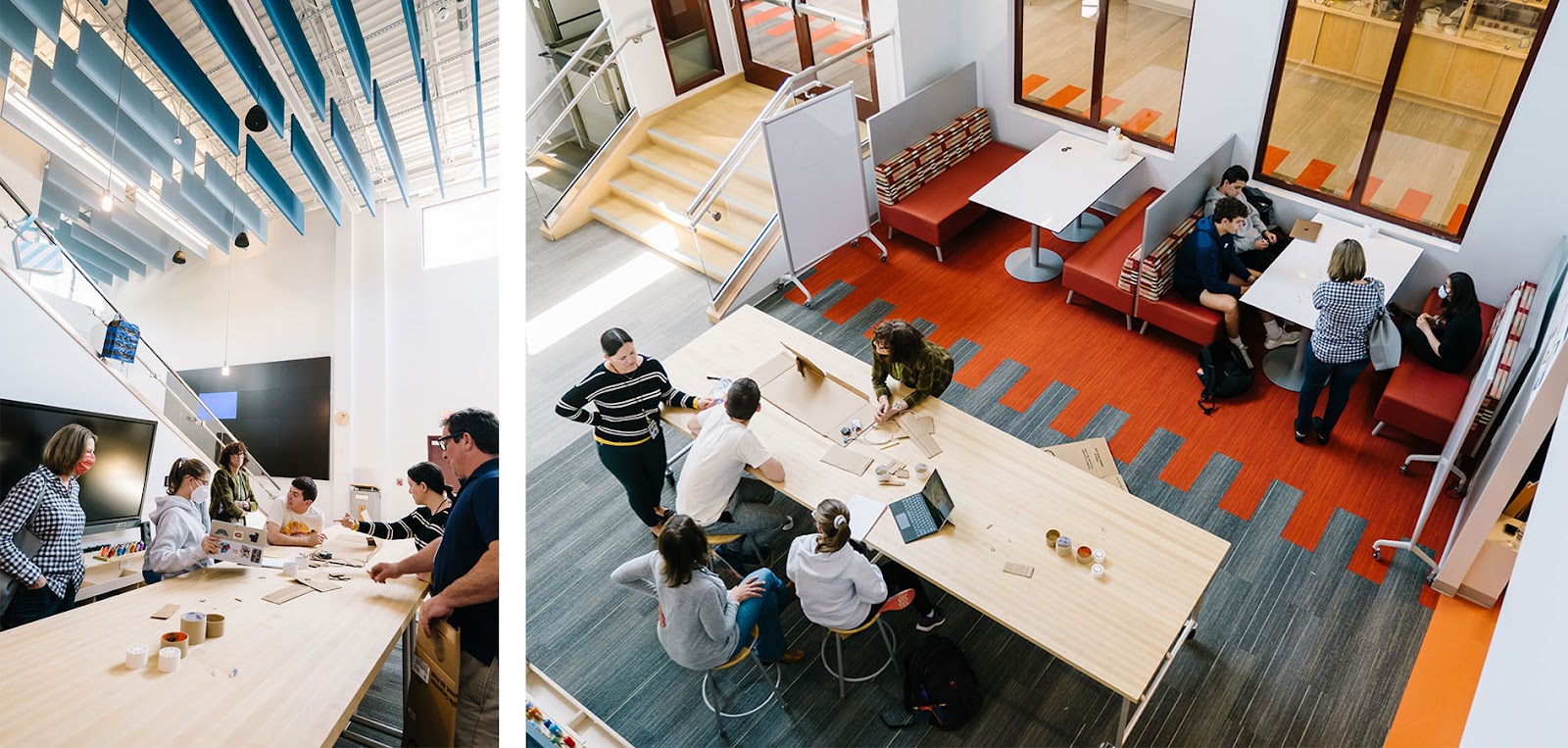
Access to Water and Storage
As noted earlier, for learning that is best achieved when students get out of their chairs and engage in hands-on activities, we provide Project Zones. These are areas that have easily cleanable flooring, a sink, and storage. For earlier grades, the project zone may serve as a place for wet and messy play. Whereas for older students, the same area can be designed as a place for small projects or a small kitchen, a universal feature that builds community and belonging
In the image below of Sinarmas World Academy, students are mastering Sumi-e, a type of Chinese ink wash painting, in the Commons.
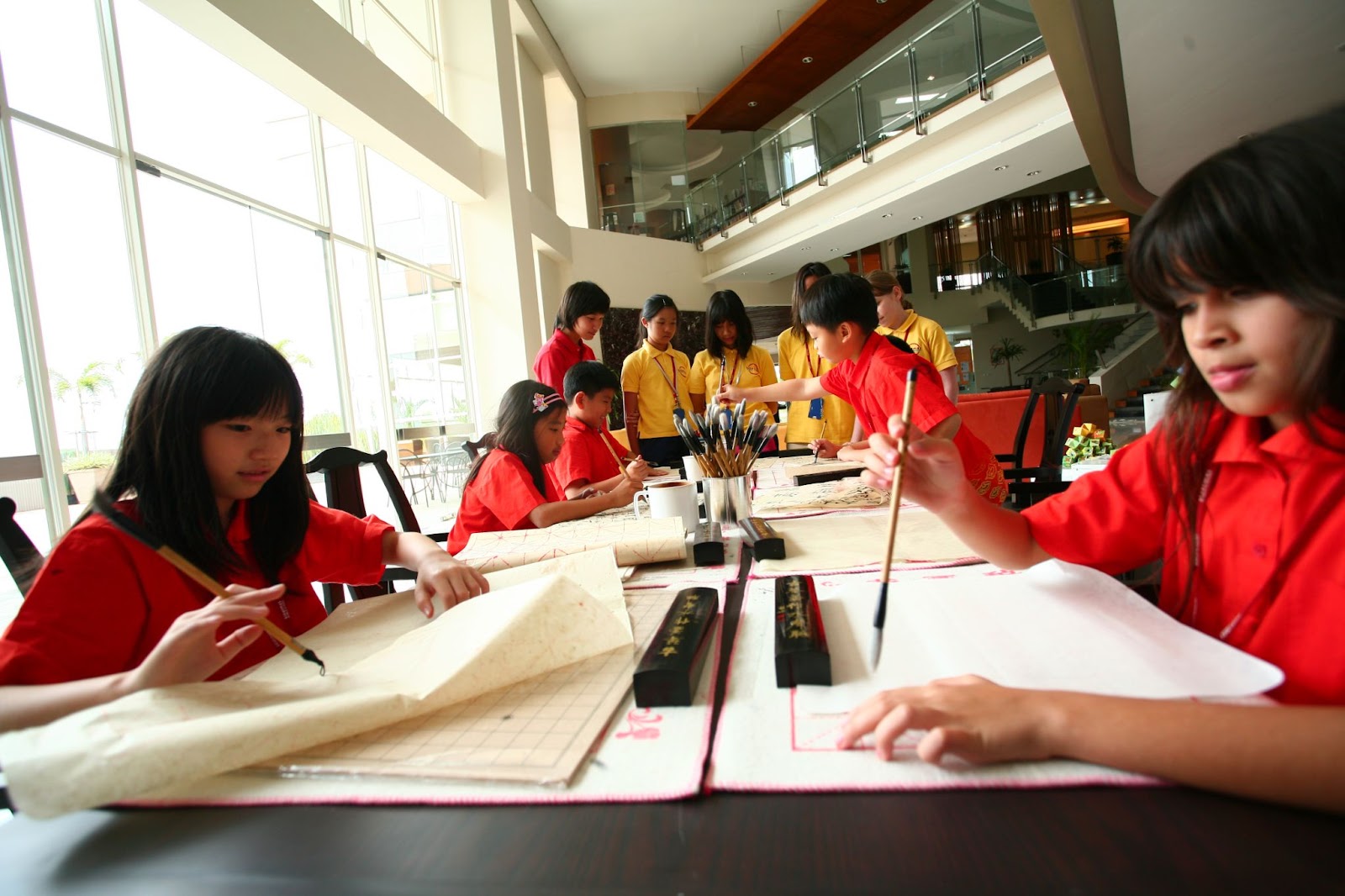
Conclusion
When a learning commons is designed with an emphasis on strong indoor-outdoor connections; visual and permeable connections to adjacent spaces; diverse activity zones; varied furnishings, fixtures, and finishes; and good sound attenuation, it naturally becomes the thriving heart of the learning community. As the thriving heart, the learning commons becomes a place that fosters a sense of love, support, and belonging, making learners truly feel at ease and at home in their school. And, when students feel loved, supported, and included, it’s possible to imagine the cascading catalytic effects this can have on learning, creativity, mental health, social-emotional growth, and so much more! So…despite a rocky history, don’t give up on the promise of vibrant Learning Commons. When you go into a school where they are well designed and teachers know how to use them, it is magical.





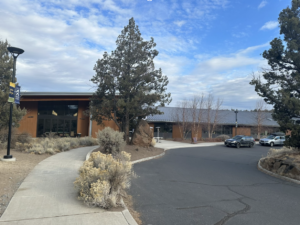
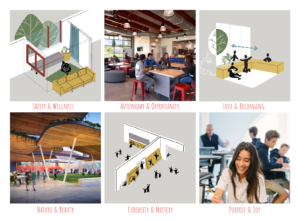

0 Comments
Leave a Comment
Your email address will not be published. All fields are required.